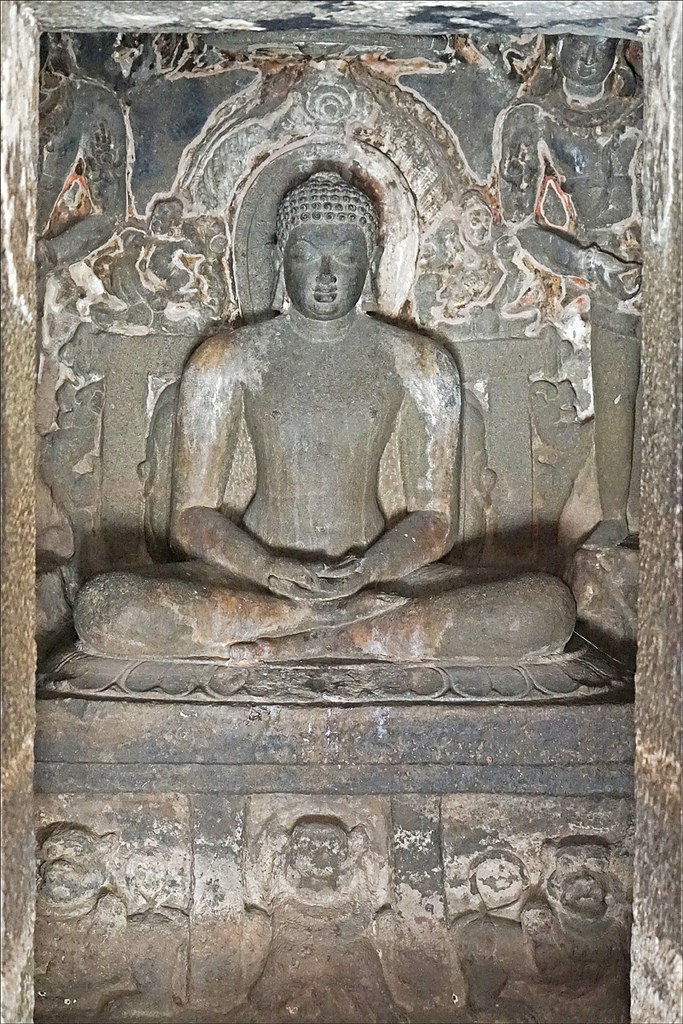Jain Temples in South India is a new weekly feature on Religion World, which gives you glimpses of different Jain shrines in the this part of the country. Rarely people are aware that Jainism has been prevalent in South India since Maurya dynasty. It became popular over the years and it was the Vijayanagar empire that made it more popular.
With Vijayanagar empire giving the much needed impetus to Jainism, it flourished and they started constructing their temples, art and culture in South India. Moreover the digambara sect also developed here and it had its own followers too. This new series Jain Temple in South India will look at different temples, the history and legend behind the temple, its uniqueness and architecture as well as its specialities. Featured on every Sunday, Jain Temple in South India will be giving its darshan in Religion World.
Jainsim in South India
Acharya Bhadrabahu Jainism had a prominent place in South India, especially in Karnataka. During the rule of the Maurya Dynasty, Chandragupta Maurya had visited Shravanabelagola with his Acharya Bhadrabahu. Kundakunda, the great Digambara Jain Acharya and philosopher also belonged to South India. All the rulers of South India including the Gagas Dynasty, Kadamba Dynasty, the Chalukya Dynasty, and the Hoysala Empire etc patronised and enthusiastically supported Jain religion. Under their rule construction of caves and rock cut temples, erection of pillars and installation of images were carried out. Jain Literature also flourished during their time. ‘

Jainism prospered in South India under the rule of Kalinga king Kharvela. He supported Jainism and helped it flourish in South India through Andhra Pradesh and the coastal ranges of Tamil Nadu. During the rule of the Maurya Dynasty, Jainism became popular in Kuntal region. It extended from the route of Avanti Janapada via Maharashtra and Andhra regions. In the early mediaeval period, the growth of Jainism was curbed by the Khilji Dynasty, the Tughlaq rule and the rise of Bahamani Kingdom. However, it gained impetus in the Hindu Vijayanagar Empire.
Construction and installation of temples and images also gained prominence at this time. Many manastambhas were erected during this period at places like Shravanabelagola, Kambadhalli, Humacha, Hiriyagarhi, Karkal, Mulki, Mudabidri. All these pilgrimages places were adorned with intricate architectural beauty. The temples reflected the magnificent work of the craftsmen. It is surprising to note that Jainism, born in east received its garb in west and south during the later period.

Shravanabelogola
Shravanabelagola is a Jain pilgrim destination located in the Hassan district of Karnataka state, Southern India. Compare to the 6 others Jain Temples; Sharavanabegola is the most archaic, unique and exotic. Seems like it comes from another dimension. The statue of Gommateshvara Bahubali is one of the most important pilgrimage destinations in Jainism, one that reached a peak in architectural and sculptural activity under the patronage of Western Ganga Dynasty of Talakad.
The Idol
The sculpture is 57 feet tall is magnificent and munificent alike-Magnificent in form and valour, Munificent in prayer and deed. The Mahamasthakabhiseka, the head anointing ceremony of the Lord Gommateshwara Sri Bahubali observed once every 12 years in Jain Dharmic cycle, an integral part of ancient and composite Indian tradition. The ceremony devotes tourist from all over the world. Said to be 1000’s year old, Gommateshvara Bahubali at Shravanabelagola is considered to be the world’s tallest Monolithic Sculpture which is carved out of a single granite rock and stands on the top of a hill.

The Legend
There are interesting stories associated with the origin of the name Shravanabelagola, which is one of the most significant pilgrimage sites in Jainism and has been preserving its art and culture for over 2 millenniums.
This ancient town in Hassan district of Karnataka which is overlooked by two rocky hills, Chandragiri and Vindhyagiri, has been derived from two words: Shramana or Shravan which means monks and Bili-goda which means white pond which is nestled between the two hills.
Another legend has it that the name was due to an old woman who poured the milk she had carried in a small bowl over the deity anointing him every day.
The statue of Gommateshvara Bahubali, erected on Vindhyagiri hill, personifies the qualities Bahubali made during his life that is birth, renunciation, enlightenment and salvation. It is believed that Bahubali offers the path to eternal happiness by helping man live a life attuned to the natural world around him and not causing any harm to any living being.
Do you know why the sculpture was built at Sharavanbelgodha? It’s an interesting tale behind. It is believed that Rishab Adinath, the first Tirthankara (an individual who achieves immortality by enlightenment), before going on his spiritual quest had to give up on his worldly pleasures. He decided to equally divide his kingdom between his two sons – Bharat and Bahubali.
But his elder son Bharata had a greater desire to become a supreme ruler and conquer every kingdom on this earth. Bahubali refused to accept his brother’s supremacy and a battle was called. However with the intervention of few wise men the battle was called off and it was decided they will fight it out by gazing into each other’s eyes, throwing water and grappling (wrestling) with each other. Bahubali emerged winner in all three
Bharata felt deeply humiliated and in a fit of rage, he threw a chariot wheel at Bahubali. However, the wheel had divine powers and didn’t harm him much. Rather it encircled Bahubali and settled at his right side. Bahubali in this moment realised that getting struck in the pleasures of fortunes will never do any good to anyone. Bahubali decided to perform a penance (mediate) by standing on his feet in order to ask forgiveness from the God. He stood in an upright position for a year exactly where the statue is today and attained the state of Kevali Arihanta –which means attaining enlightenment and salvation

The Specialities
Weighing approximately 80 tons, carved from a single rock, the accuracy and sense of proportion is spellbinding. Curly ringlets with eyes open, facial features perfectly chiseled with a faint touch of a smile at the corner of the lips. Broad shoulders with arms stretched straight downwards, the statue looks so surreal.
The anthill is symbolic of incessant penance with a snake and creepers twined around the legs. The arms have a cluster of flowers which are artistically carved. The posture of meditation known as Kayotsarga, symbolizing renunciation and self-control, which is considered the first steps towards salvation.
The entire figure stands on an open lotus, with two tall and majestic chauri bearers on either side. One named yaksha and the other yakshi.
The statue was installed and consecrated by Chavundaraya, the Prime Minister and Commander-in-Chief under the rulers- King Marasimha II, Rachamalla IV and Rachamalla V of the Talakad Ganga Kingdom in 981 A.D.
Inscriptions in Kannada and Tamil can be seen at the base of the statue. A treasure trove of 500 inscriptions, some of them refer to Sallekhana (starving to death) observed by Jaina ascetics. Most of the inscriptions at Chandragiri date back to the 10th century. These inscriptions have helped modern scholars analyze the nature, growth and development of Kannada language and its literature.
Every twelve years devotees perform the Mahamastakabhisheka to the statue of Lord Gomateshwara. Water kept in 1008 kalashas (vessels) is collected from almost all the rivers and water resources to bathe the statue. Jain priests pour pots of curd, milk, honey, vermilion, coconut water, turmeric paste including gold and silver coins during the ceremony. This year Mahamastakabhisheka was held from February 9 to February 26.
Jain Tirtha and Tirthamkara
The etymological basis of a Tirtha as a holy place of worship can be properly traced to the term Tirthamkara which signifies a liberated soul according to Jain religions tradition. A Tirthamkara is one who has eliminated the last vestiges of Karmic pollution attaching to the soul through a rigorous ascetic regimen prescribed in Jain religious canon, known as agamas and has attained omniscience. He thus becomes a creator of a Tirtha or a Tirthamkara, a fordmaker. It is by means of this Tirtha, or ford, a worldly being can cross this life and attain moksa. It is in this context of the unique Jain connection of the term Tirtha, a historic genesis of the temple tradition and idol or icon worship can be traced in Jain religious practices since prehistoric times.
In the allegorical or spiritual sense, the dictionary meaning of the term‘pilgrim’ is “one journeying through life as a stranger in this world.” As a matter of fact, in Jainism a place of pilgrimage is called a tirtha or tirtha-ksetra. A tirtha (Literally, a ford) is so called because it helps the aspirant in crossing the ocean of samsara which is full of pain and suffering and in attaining liberation from the unending round of rebirths.
A Jain Tirthamkara is a maker of such a ford or bridge. The very concept of pilgrimage, of going to a sacred place for spiritual edification is embodied in the term Tirthamkara which is the ultimate symbol of Jain liberation and also the ideal. It is thus are extension of the process of ritual of worship in Jainism.
Pilgrimage to holy places, Tirtha-Ksetras for a Jain is a concrete reminder of the Jain Tirthamkaras, deities, and events in their lives such as birth, nirvana which is held to be sacred and memorable. A visit to such places is meritorious and spiritually purifying.
Such exalted sites of Jain pilgrimage fall into four categories. The Kalyanaka Ksetras associated with the birth and other memorable events in the life of the Tirthamkara ; the Siddha-Ksetras or Tirtha-Ksetras where countless arahats- liberated non-Tirthamkaras- attained liberation; nirvana-bhumi, where certain Tirthamkaras attained liberation; the Atishaya-Ksetras associated with miraculous events in the lives of great monks and Kala-Ksetras reputed for their artistic monuments, temples and images many a time, more than one of these characteristics are present at one and the same site.
As the Jain Tirthamkaras and ascetics have always carried out their austerities in secluded places, forests, far from the human habitation and mountain-tops, it is not surprising that the Jain Tirtha-Ksetras are situated in such places in the midst of captivating scenery and peaceful surroundings conducive to concentrated meditation and spiritual contemplation.
The sacred association of the place (such as nirvana, birth of Tirthamkara) give it an added sanctity. Jains place great value upon pilgrimage to such shrines. Indeed, a common Jain considers it an important goal of his life to make at least one visit, with his family if possible, to one or more of several Tirtha-Ksetras Jainism holds as sacred.
During the pilgrimage the entire time is spent in different religious activities such as continence, abstinence, fasting worship, meditation, study of scriptures, listening to religious discourses, chanting and recitation of religious hymns or devotional songs and charity.
In Jainism, pilgrimage is a ritual that is shared by the laity and the monastic community. Pilgrimage lends structure to the wanderings of Jain monks and nuns, who are forbidden from living long in one place and who thus spend their ascetic life in traveling on feet from one place to another except during the rainy season- Varshayoga or Chaturmasa.
Must read 10 Healthy Tips to Reduce Your Sleep Quota : Sadhguru Jaggi Vasudeva









